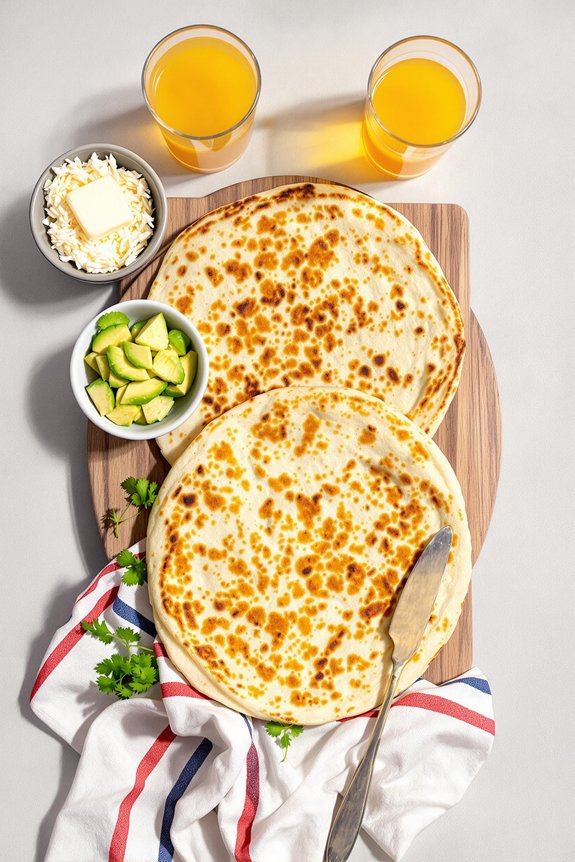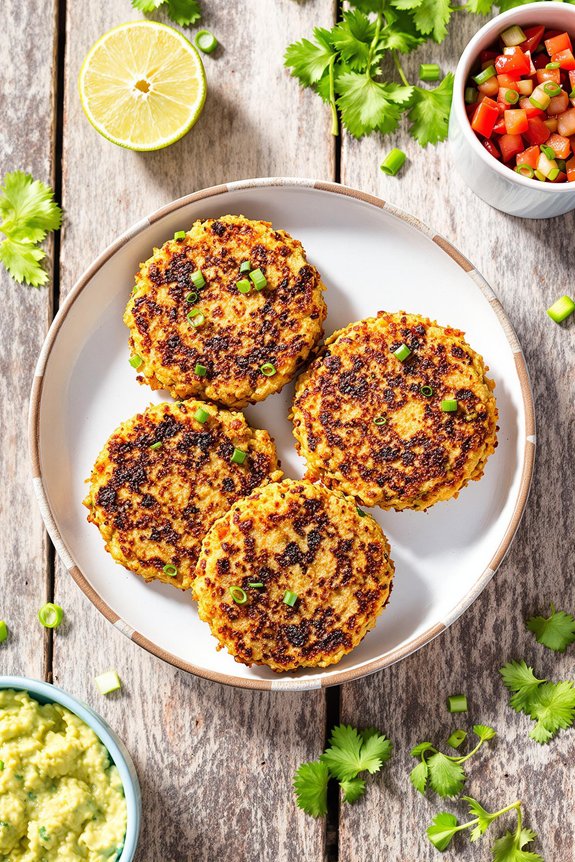Why You’ll Love this Crispy Venezuelan Arepa
Once you bite into these crispy Venezuelan arepas, you’ll wonder how you’ve lived without them all this time.
These golden discs of cornmeal goodness offer the perfect balance—crispy exterior, soft, pillowy interior. They’re incredibly versatile, too. Stuff them with cheese, shredded beef, or avocado for a meal that’s both comforting and satisfying.
What makes them truly special? The buttermilk option adds a subtle tanginess that elevates the flavor beyond ordinary cornbread.
Plus, they’re naturally gluten-free if you skip the small amount of flour. Perfect for breakfast, lunch, or dinner—anytime you crave something warm and homemade.
What Ingredients are in Crispy Venezuelan Arepa?
Making Venezuelan arepas requires just a handful of simple ingredients that come together to create something truly magical. The star of the show is masarepa, a pre-cooked cornmeal specifically made for arepas—not to be confused with regular cornmeal or masa harina used for tortillas. This special cornmeal gives arepas their distinctive texture and authentic flavor, creating that perfect balance between crispy exterior and soft interior we all crave.
- 2 cups masarepa cornmeal
- 1 1/4 cups warm water
- 1/2 cup milk or buttermilk (buttermilk adds a lovely tang)
- 4 tablespoons butter, melted
- 1 teaspoon salt
- 2 tablespoons flour
- 1/2 teaspoon sugar
When shopping for these ingredients, there are a few things to keep in mind. First, masarepa is sometimes labeled as “pre-cooked cornmeal” or “harina precocida” in Latin American grocery stores. The brand P.A.N. is widely available and considered excellent quality.
If you’re looking to make these gluten-free, you can actually omit the small amount of flour—it helps with texture but isn’t strictly necessary. And while regular milk works perfectly fine, don’t hesitate to try the buttermilk version for a subtle complexity that takes these arepas to the next level. Who knew such humble ingredients could create something so delicious?
How to Make this Crispy Venezuelan Arepa

Making Venezuelan arepas is surprisingly simple, though there’s a bit of technique involved to get that perfect texture. Start by preheating your oven to 325 degrees, then gather all your ingredients for mixing.
In a large bowl, combine 2 cups of masarepa cornmeal with 1 1/4 cups warm water, 1/2 cup milk (or buttermilk for extra flavor), 4 tablespoons melted butter, 1 teaspoon salt, 2 tablespoons flour, and 1/2 teaspoon sugar. Mix everything thoroughly until you have a very smooth mixture. Don’t fret if the dough seems a bit wet at first—this is actually normal. Cover the mixture and let it rest for about 5-10 minutes, giving the cornmeal time to absorb the liquid properly.
After resting, your dough should feel smooth and easy to handle without sticking to your hands. This is the moment of truth in arepa-making. If the dough feels too dry, you can add a splash more water or milk; if it’s too wet to shape, incorporate a small amount of additional masarepa. Knead the dough for several minutes until smooth, then let it rest again for 5 minutes.
Now comes the fun part: shaping your arepas. Take portions of dough and form them into round disks about 2 centimeters thick and 3 to 3 1/2 inches in diameter. See any cracks forming along the edges? Simply repair them with slightly moistened fingers. The dough should be cooperative—if it’s cracking notably, you might need to knead in a bit more liquid.
Time to cook these beauties! Lightly grease a heavy skillet (cast iron works wonders here) with vegetable oil and heat it over medium heat. Place your shaped arepas in the skillet in batches, reducing the heat to medium-low. Cook until they develop a light golden-brown crust on each side, about 2-3 minutes per side.
This stovetop cooking creates that irresistible crispy exterior, but the magic isn’t complete yet. Transfer your partially cooked arepas to a cookie sheet and slide them into your preheated oven for 8-10 minutes. For even crispier results, consider using a premium large air fryer instead of the oven for the final cooking stage. This final baking step guarantees the insides cook through completely without burning the crispy exterior.
When they emerge from the oven, warm and aromatic, they’re ready to be served with butter or cheese. The contrast between the crispy shell and the tender, steamy inside? Pure Venezuelan comfort food at its finest.
Crispy Venezuelan Arepa Substitutions and Variations
While traditional Venezuelan arepas are magnificent in their classic form, there’s plenty of room for creative substitutions and variations that can accommodate dietary restrictions or simply add new flavors to this beloved dish.
For dairy-free options, I recommend coconut oil instead of butter and plant-based milk as substitutes.
Need it gluten-free? Skip the flour entirely—the masarepa cornmeal is naturally gluten-free.
Flavor-wise, try adding shredded cheese, minced garlic, or chopped herbs directly into the dough. My personal favorite? A hint of cumin and diced jalapeños for heat.
The beauty of arepas lies in their versatility, a blank canvas waiting for your culinary touch.
What to Serve with Crispy Venezuelan Arepa
Now that we’ve explored arepa variations, let’s talk about what actually goes alongside these golden, crispy discs of cornmeal goodness.
I love serving arepas with traditional Venezuelan accompaniments like shredded beef (carne mechada), black beans, or queso fresco. For a simple breakfast, just butter and a sprinkle of salt works wonders.
A vibrant avocado salad makes the perfect side, with its creamy texture contrasting the arepa’s crunch.
And don’t forget a tangy cilantro sauce to drizzle over everything!
Truth be told, arepas are incredibly versatile—they can handle anything from morning eggs to evening stews, making them the ultimate food canvas.
Final Thoughts
As I’ve guided you through this crispy Venezuelan arepa recipe, I’ve come to appreciate how these humble cornmeal discs represent so much more than just food.
They’re vessels of culture, history, and community.
Arepas remind us that sometimes the simplest ingredients—cornmeal, water, salt—can create something truly extraordinary.
Whether you’re filling them with cheese, meat, or eating them with just a pat of butter, they offer endless possibilities.
What makes cooking special isn’t just the end result, but the journey.
The feeling of the dough in your hands.
The sizzle in the pan.
The first warm, crispy bite.





